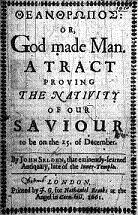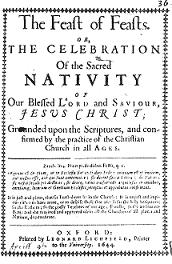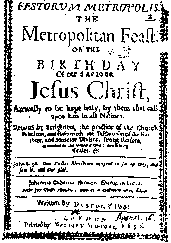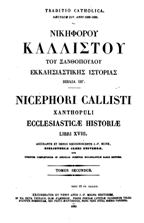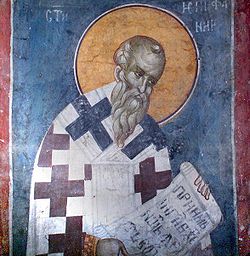Loosing the Riddle of Clement
For the Nativity, Baptism,
Passion, and
Epiphany of Christ
Kurt Simmons, Esq.
Clement
"And
there are those who have determined not only the year of our
Lord's birth, but also the day; and they say that it took place
in the twenty-eighth year of Augustus, and in the twenty-fifth
day of Pachon. And the followers of Basilides hold the day of
his baptism as a festival, spending the night before in
readings. And they say that it was the fifteenth year of
Tiberius Caesar, the fifteenth day of the month Tybi; and some
that it was the eleventh of the same month. And treating of his
passion, with very great accuracy, some say that it took place
in the sixteenth year of Tiberius, on the twenty-fifth of
Phamenoth; and others the twenty-fifth of Pharmuthi and others
say that on the ninetheeth of Pharmuthi the Saviour suffered.
Further, others say that he was born on the twenty-fourth or
twenty-fifth of Pharmuthi."
[3]
There are three dates given for the birth
of Christ, and two for his baptism, and three for his
crucifixion:
Table No. 1
Egyptian Dates given by Clement
|
Nativity |
Baptism |
Passion |
|
Pachon 25 or Pharmuthi 24 or 25 |
Tybi 15 or 11 |
Phamenoth 25 or 19, Pharmuthi 24, 25 |
The months given are from the Egyptian
calendar in use in
Table No. 2
Egyptian vis-à-vis Roman Calendar[4]
|
Thot 1-30 Paophi 1-30 Athyr 1-30 Choiack 1-30 Tubi 1-30 Mechie 1-30 Phamenoth 1-30 Pharmuthi 1-30 Pachon 1-30 Payni 1- 30 Epiphi 1 -30 Mesori 1-30 Epagomenal days |
Aug 29-Sept 27 Sept 28-Oct.27 Oct. 28- Nov. 26 Nov. 27-Dec. 26 Dec. 27-Jan. 25 Jan. 26-Feb. 24 Feb. 25-Mar. 26 Mar. 27-April 25 April 26-May 25 May 26-June 24 June 25-July 24 July 25-Aug. 23 Aug. 24-Aug.28 |
The Egyptian calendar was a solar calendar,
similar to the Julian/Gregorian. However, where the
Julian/Gregorian calendars distribute the 365 1/4 days of the
solar year by alternating months between thirty and thirty-one
days (except February), and providing for a leap year every
fourth year, the Egyptian year consisted of twelve months of
thirty days each (360 days) with five "epogomenal" ("inserted")
days added at the end of the calendar, and a leap year
intercalated every fourth year, or as necessary. The
distribution of days in the Egyptian calendar therefore appears
identical with the calendar used during the time of Noah, which
was also a solar calendar with months of 30 days (see Gen.
7:11-8:4 where 150 days fulfilled five months between the
seventeenth day of the second month and the seventeenth day of
the seventh month). This was changed by the law of Moses,
however, where time was marked, and the annual cycle of feasts
were governed, by a lunar calendar, which was true of most
ancient peoples at that time. We believe the use of lunar
calendars by Jews and other ancient people is reflected in the
dates given by Clement.
The primary and alternative dates provided for the
nativity and passion of Christ (Pharmuthi
25/Pachon 25,
Phamenoth 25/Pharmuthi 25)
are each set exactly thirty days apart, and are best interpreted
as reflecting the intercalation of an extra month for leap years
in a lunar calendar. Since questions about the different types
of calendars have come up, let us take this matter first.
Clement's Dates and Lunar Calendars
The lunar year is 11 days shorter than the
solar year. Twelve lunar months equals 354 days. The Greeks,
Jews, and other ancient peoples therefore added an extra month
seven times in 19 years in order to bring the lunar year back
into synchronization with the solar year. The formula by which
an extra month was intercalated is credited to the Greek
mathematician, Meton of Athens, and the
Metonic table
allows us
to determine where extra months were inserted by the Greeks. The
Jews also used a 19 year cycle, but the mathematical formula
they used was so contrived that once in 19 years the Jews' leap
year does not correspond with the Metonic table and
vice versa.[5] By
consulting these tables, we can determine if the years preceding
the nativity and passion of Christ were leap years.
If so, the alternative dates provided by Clement should
reflect this fact.
Clement says Jesus was born in the
twenty-eighth year of Augustus. The twenty-eighth year of
Augustus, numbering from the death of
Clement states that Christ's passion was
believed by some to have occurred
Pharenoth 25 but
others Pharmuthi 25. Jesus' actual death was Nisan 15, A.D. 33. By both the Jewish and
Metonic tables, A.D. 32 was a leap year. Thus, Nisan 15, A.D.
33, would have fallen one month later than it otherwise would.
But Clement does not give A.D. 33 for Jesus' death, but the
sixteenth year of Tiberius or A.D. 30.
Here, too, however, we find that according to the Jewish
formula the preceding year (A.D. 29) was a leap year.
Thus, in both cases - the actual and assumed dates of
Christ's death - the preceding year was a leap year, causing the
date of Christ's passion to fall thirty days later than it would
have otherwise.
The coincidence that in both cases (the
nativity and passion) the alternative dates given by Clement are
exactly thirty days apart and were both leap years makes all but
inescapable the conclusion that they reflect an attempt to take
account of variables arising in lunar calendars. Finegan does
this very thing in his
Handbook of Biblical Chronology, where he gives a range of
possible dates for Christ's crucifixion with alternative dates
one month later in the event the preceding year was a leap year.
However, Finegan makes a mistake for the year A.D. 33, by
putting forward alternative dates of May 2 or 3 for Christ's
passion assuming A.D. 32 was a leap year, not realizing that the
primary dates of April 3 or 4 already reflect the intercalation
of an extra month.[6]
Finegan's mistake demonstrates the difficulty inherent in
working with foreign calendars, and how the very thing we are
describing is the best explanation for Clement's dates.
Certainly, those who put forward the alternative dates
reported by Clement had a reason for doing so. And as there is
no other or better explanation than the unique characteristic of
lunar calendars and the method by which an extra month was added
in leap years, we may take this much of the riddle as all but
settled.
The Twenty-fifth in Clement's Scheme
One of the first things that strikes us as
curious about Clement's report is the appearance of the
twenty-fifth as the date of Christ's birth, once in the month
Pachon and again in
Pharmuthi. When
speaking of the date of Christ's passion, Clement says some gave
the date of Phamenoth
19 or 25, others Pharmuthi
24 or 25. Thus, the twenty-fifth day of the month appears twice
more. We will look
at the other dates shortly, but for now let us focus on the
significance of the dates given as the twenty-fifth.
Phamenoth 25 (March 21) is the date of the vernal equinox.
The rest of the natural divisions of the year in the Egyptian
calendar are the summer solstice
Panyi 27 (June 21), the autumnal equinox
Thot 25 (Sept. 22), and the winter solstice
Choiack 25 (Dec. 21). In the Roman calendar, the civil dates of the
vernal and autumnal equinoxes were March 25 and September 24,
and the summer and winter solstices June 24 and December 25,
respectively. We say "civil dates" as distinguished from natural
dates, meaning the dates marked in the calendar for religious
holidays when government offices were closed versus the actual
astronomical events they nominally marked. Although originally
the natural divisions of the year coincided with the civil
dates, through mismanagement of their calendar and irregular
placement of leap years, the civil dates and astronomical events
they marked grew out of synchronization. Because of this, Julius
Caesar reformed the Roman calendar, but even his efforts failed.
The length of the solar year is 365 days 5 hours 49 minutes 12
seconds. The Julian calendar set the year at exactly 365 days 6
hours - a difference of just less than eleven minutes. This
difference caused the Julian calendar to lose one day about
every 131 years (60 x 24 = 1440 ÷ 11 = 130.9090909). Because of
this and other factors, when Christ was born the equinoxes and
solstices anticipated
the civil dates by about a day and a half. That is, the
equinoxes and solstices occurred before their dates marked in
the calendar. This difference continued to grow until A.D. 325,
when, in order to establish the uniform observation of the
Pasche (Easter), the Council of Nicea was forced to correct the
date of the equinox by
four days, from March 25 to March 21, so that it
corresponded with the actual astronomical event. However, this
was only a temporary fix; the same defect in the Julian calendar
still remained uncorrected until institution of the Gregorian
calendar in 1582.
When the Gregorian calendar was instituted,
ten days had to be
removed to return the vernal equinox to March 21, where it has
remained ever since (allowing for variation due to leap years).
In correcting the date of the vernal equinox, the remaining
divisions of the year were also necessarily moved, so that today
the winter solstice falls Dec. 21, the summer solstice June 21,
and the autumnal equinox September 22.
Thus, the twenty-fifth occupies a special
place in both the Roman and Egyptian calendars as a number
associated with the natural divisions of the year. Three dates
in the Egyptian calendar - the autumnal equinox, the winter
solstice and the spring equinox - fell on the 25th of their
respective months, and two dates in the Roman calendar - the
winter solstice and spring equinox - fell on the 25th of their
respective months. We believe that the dates given by Clement
ultimately have in view the spring equinox and winter solstice
in the Roman calendar. Let's take each of these in order.
Clement's Dates and the Civil Equinox of
The principal date give by Clement for
Jesus' crucifixion is
Phamenoth 25 (March 21), the date of the vernal equinox in
the Egyptian calendar. That this date is ultimately derived from
the Roman calendar is clear.
First, it is impossible that Christ died on the vernal
equinox as supposed by the Egyptian date of
Phamenoth 25. The Jews
had a lunar calendar and Passover was so timed as to
always occur at the full moon (Abib/Nisan 14)
on or after the vernal equinox (Ex. 12:1-28; Lev. 23:5; Num. 9:4,
5). But Christ died Good Friday, Nisan 15, the day
following Passover (Matt. 26:2, 17; Lk. 22:7, 15; Jn. 13:1, 2).
Since the earliest Passover can occur is the day of the equinox
where this corresponds with the full moon, Jesus' death the day
following makes impossible
his crucifixion on the day of the equinox itself. Thus the date
of Phamenoth 25 is
clearly incorrect: Jesus did not die on the equinox.
Second, although it is impossible that Jesus died on the
equinox, it is possible, at least in theory, the Lord died on
the date of the civil
equinox in the Roman calendar. As will be recalled, the actual
equinox anticipated the civil date of March 25 by about one day.
Thus, Passover could have occurred on the equinox March 24, with
Jesus' death on the date of the civil equinox March 25 the day
following. This is
apparently what men believed occurred.
For the years A.D. 30-33, the possible range of years
covering Christ's ministry in which Passover occurred, the
following dates appear:
Table No. 3
Dates of Passover in the Gospels
|
Passover A.D. 30 |
Passover
A.D. 31 |
Passover
A.D. 32 |
Passover
A.D. 33 |
|
April 4 |
March 24 |
April 12 |
April 1 |
From the table above, we see that in A.D.
31 Passover occurred on March 24, what was probably the actual
date of the equinox. Supposing Christ died that year, the day
following would have been the day of the civil equinox in the
Roman calendar. Thus, belief Jesus died in A.D. 31 is almost
certainly the source of the error that he died on the day of the
vernal equinox. This
is the date given by Tertullian (the seventy "hebdomads" refers
to Daniel's seventy prophetic weeks allotted to the coming of
the Messiah and destruction of the Jewish state - Dan. 9:24-27):
"And
the suffering 'extermination' was perfected within the time of
the lxx [70] hebdomads, under Tiberius Caesar, in the consulate
of Rubellius Geminius and Fufius Geminus, in the month of March,
at the times of the Passover, on the eighth day before the
calends of April."[7]
Eight days before the calends of April is
March 25. Finegan's table of consuls gives the consulship of
Gemino et Gemino as
A.D. 29,[8] but this
is clearly not the date contemplated by Tertullian. By comparing
Hippolytus and Epiphanius, it becomes clear that Tertullian has
in mind A.D. 31. Here is Hippolytus:
"For the first advent of our Lord in the flesh, when he was born in
The consul Hippolytus calls "Rufus,"
Tertullian calls "Fufius," for these are variations of the same
name and thus signify the same year. These same consuls are
mentioned by Epiphanius:
"All
this was fulfilled beginning with Christ's birth in Bethlehem,
in the forty-second year of the whole reign of Augustus…For in
fact, it was in the thirty third year of his incarnation that
the Only-begotten suffered for us…For after that consulship
which came, as I indicated in Christ's thirtieth year, there was
another, called the consulship of Rufus and Rubellio. And then,
at the beginning of the consulship after the consulship of Rufus
and Rubellio - the
one which later came to be called the consulship of Vinnicius
and Longinus Cassius - the Savior suffered on the thirteenth
before the Kalends of April in his thirty-third year, which was
the eighteenth year of Tiberius Caesar."[10]
Both Hippolytus and Epiphanius date
Jesus' birth to the forty-second year of Augustus, and his death
to the same age, but to different consulships and years. Both
say Jesus died in the eighteenth year of Tiberius in the
thirty-third year of his life. However, where Hippolytus
and Tertullian say Jesus died in the consulship of Rufus and
Rubellio, Epiphanius places Jesus' death in the following year
under Vinnicius and Longinus. The reason for this appears to be
that Hippolytus believed Jesus was born Dec. 25th, but
Epiphanius believed he was born Jan. 6th and therefore carries
his death over to the following year.
Dating from the death of Julius Caesar in 44 B.C., the
forty-second year of Augustus would be 2 B.C., making Christ's
thirty-third year A.D. 32. Augustus died in August, A.D. 14,
making the eighteenth of Tiberius also A.D. 32. This seems to be
the date contemplated by Epiphanius. This would make the preceding year
- A.D. 31 - that contemplated by Tertullian and Hippolytus.
This raises an important question:
If Christ did not
die on the actual equinox, how is it that the Egyptians placed
Christ's death on the day of the equinox in the Egyptian
calendar, unless that tradition was first published abroad based
upon the error inherent in the Roman calendar? No year in
the possible range of Jesus' life allows for his death on the
Egyptian equinox (March 21). Nisan 15 may have answered March 25
in the relevant range of years, but never did Nisan 15 equate with
March 21. The only
equinox possible is the civil equinox of the Romans, and this
based upon the erroneous assumption Christ died in A.D. 31.
Hence, Phamenoth 25
must be seen as actually pointing to March 25 and not to a date
in the Egyptian calendar at all. No one sitting in
If, as we have seen,
Phanemoth 25 refers to
the civil date of the vernal equinox in the Roman calendar, what about
the date given for Jesus' birth, does it too actually refer to a
date in the Roman calendar,
viz., the winter
solstice December 25? We
believe it does.
Clement's Dates and the Winter Solstice in the Roman Calendar
According to the report of Clement, Jesus
was born either Pachon
25 (May 20) or Pharmuthi
25 (April 20), and baptized
Tybi 11 or 15 (Jan. 6
or 10). However,
these dates conflict with established chronology in the gospels.
Luke tells us that Jesus was baptized the fifteenth year
of Tiberius (A.D. 29), on the threshold of his thirtieth
birthday (Lk. 3:1, 23). Following his baptism, Jesus underwent a
period of fasting and temptation in preparation for his ministry
(Lk. 4:1, 2). He
then returned to John at Bethabara where he proceeded to make
his first disciples, Andrew and Peter, Phillip and Bartholomew
(Jn.
“For how could he have had disciples, if
He did not teach? And how could He have taught, unless He had
reached the age of a Master?
For when He came to be baptized, He had not yet completed
thirty years of age (for thus Luke, who has mentioned His years,
has expressed it: ‘Now Jesus was, as it were, beginning to be
thirty years old,’ when He came to be baptized).”[11]
In other words, at that point where Jesus
began making disciples and teaching he had turned thirty and
this must have occurred
before his return to John at Bethabara, not following the
first Passover of his ministry months later. Hence, Clement's
scheme placing Jesus birthday in late April or May is clearly
erroneous. Since Clement's dates for the nativity are erroneous
on their face, they argue, as in the case of the vernal equinox
and the Passion of Christ, that they have been misapplied from
another calendar. As
the impossibility that Jesus' died on the equinox in the
Alexandrian calendar proved that the date given by Clement
originated in the Roman calendar, so here, the impossibility of
Jesus' thirtieth birthday occurring several months into his
ministry convince us that Clement's dates derive from foreign
sources. But what sources are we to look to?
Clement's Dates Misapplied from Athenian Calendar
What we propose is that the date of the
nativity was translated early on from the Jewish to the Roman,
but arrived in
Table No. 4
Egyptian, Roman, Jewish, and Athenian Calendars
|
Egyptian |
Roman |
Jewish |
Athenian
|
|
Thot |
September |
Elul (6) |
Boedromion (3) |
|
Pauphi |
October |
Tishri (7) |
Pyanopsion (4) |
|
Athyr |
November |
Heshvan (8) |
Maimakterion (5) |
|
Choiak |
December = "tenth" |
Casleu (9) |
Posideion (6) |
|
Tybi |
January |
Tebet (10) |
Gamelion (7) |
|
Mechir |
February |
Shebat (11) |
Anthesterion (8) |
|
Phamenoth |
March |
Adar (12) |
Elaphebolion (9) |
|
Pharmuthi |
April |
Nisan (1) |
Mounychion (10) |
|
Pachon |
May |
Jyar (2) |
Thargelion (11) |
|
Payni |
June |
Sivan (3) |
Skirophorion (12) |
|
Epiphi |
July |
Tammuz (4) |
Hekatombaion (1) |
|
Mesori |
August |
Ab (5) |
Metageitnion (2) |
The Roman calendar originally began the
year in March. This is seen by the names of the several months,
beginning with Quintilis, derived from the Latin for fifth, and
Sextilis, derived from the Latin for sixth. These were later
substituted for July and August in honor of Julius Caesar and
Augustus Caesar. However, the remaining months through December
still bear witness to the original beginning of the year with
March. Thus, September is derived from the Latin for seventh,
October, from the Latin for eighth, November, for the ninth, and
December, for the tenth. In this way, Jesus' birthday may have
been translated to the Roman calendar by the first disciples,
who circulated that Jesus was born the 25th day of month the
Romans call the tenth (December).
This information, having found its way to Athens and
thence to Alexandria where it was supposed the "tenth month" had
reference to the Athenian calendar, was misapplied to the
Egyptian calendar, the tenth month of the Athenian calendar (Mounychion)
being taken as seasonal equivalent for the eighth month (Pharmuthi)
of the Egyptian. This would account for the report given by
Clement that some thought the date of the nativity was
Pharmuthi 25. It also
allows for the alternative date of
Pachon 25 to reflect
dating issues arising in the Jewish lunar calendar, for
Pachon 25 is thirty
days later than Pharmuthi
25.
That this sort of thing may have happened is likely enough. Unlike today where there is a universal method of dating time, in the time of Christ each country and even city had their own calendar with years starting at different seasons, with weeks and months of different lengths beginning at different times. The hemerologium, a calendar of months of different cities, which exists in two manuscripts, gives the Roman calendar beginning in January and the calendars of some sixteen other cities in comparison of it, including the 1) Alexandrians, 2) Syrian Greeks, 3) Tyre, 4) Arabia, 5) Sidon, 6) Heriopolis, 7) Lycia, 8) Asia, 9) Crete, 10) Cyprus, 11) Ephesus, 12) Bethynia, 13) Cappodicia, 14) Gaza, 15) Ascalon, and 16) Seleucia Pieria.[12] Similarly, when Epiphanius gives the supposed date of Christ's baptism, he uses the Roman date first, and then proceeds to translate it into ten different calendars.[13] With so many calendars in use along side one another, it is not difficult to imagine how dates originating in one calendar might easily be mistaken to refer to another and so be misapplied. Indeed, we have seen this very thing in the case Christ's passion where the date of the civil equinox in the Roman calendar was mistaken with the equinox of the Alexandrian. This also occured in regard to celebration of the Nativity in the Apostolic Constitutions:
"Brethren,
observe the festival days; and first of all the birthday which
you are to celebrate on the twenty-fifth of the ninth month.
Almost all scholars agree that the
twenty-fifth day of the ninth month signifies December twenty-fifth, April being taken as the first month
among many of the early fathers. Since the date given by Clement for Christ's birth conflicts
with scripture and is untenable, we are forced to explain it by
other means. When
viewed through the prism of the Athenian calendar, we find that
the traditional date of December 25 comes forth quite naturally.[14]
Clement and the Baptism of Christ
Clement gives the date of Jesus' baptism as
either Tybi 11 or 15
(Jan. 6 or 10). These dates are also erroneous on their face. It
is a well established fact that Jesus' ministry was 3 1/2 years
long, beginning with his baptism and ending with his death on
Table No. 4, Forty-two Lunar Months of Christ's Ministry
|
Nisan 15, A.D. 33
(Crucifixion)
Adar,
Shevat,
Tebet,
Cesleu,
Heshvan,
Tishri,
Elul,
Ab,
Tammuz,
Sivan, Jyar |
|
Nisan 15, A.D. 32 (12
months)
Adar II, (leap year)
Adar,
Shevat,
Tebet,
Cesleu,
Heshvan,
Tishri,
Elul,
Ab,
Tammuz,
Sivan,
Jyar |
|
Nisan 15, A.D. 31, (25
months)
Adar,
Shevat,
Tebet,
Cesleu,
Heshvan,
Tishri,
Elul,
Ab,
Tammuz,
Sivan,
Jyar |
|
Nisan 15, A.D. 30, (37
months)
Adar,
Shevat,
Tebet,
Cesleu,
Heshvan 15, A.D. 29
(42months) |
Reckoning three and a half years backward
from this date will bring us to Heshvan 15, AD (Nov. 8).
Thus, Christ was baptized
in November, not January.
Epiphanius' chronology of the first sixty days of Jesus'
ministry following his baptism is in accord, beginning in
November and ending January 6 at the wedding in
"And
so you see that after the twelfth of Athyr, when he had gone
away and been tempted for forty days, and then come to Nazareth
and stayed there for about two weeks and three days, he next
went down to the Jordan to see John and spent a first day there,
and a second; and then he returned to Nazareth, and likewise
stayed there for a first and a second day. And on the third day
he went to
The twelfth of Athyr answers to
November 8, which answers to Heshvan 15 in the Jewish calendar.[16] Jesus' baptism fell on the fifteenth day of
the month, and Clement reports that the followers of Basilides
kept the fifteenth in commemoration of that event.
Although the months do not correspond (Heshvan 15 = Nov.
8, Tybi 15 = Jan. 10), the coincidence that the days correspond
suggests another example where dates derived from one calendar
have been misapplied to the Egyptian.
Now, Heshvan 15
in the Jewish calendar corresponds with
Metagitnium 15 in the
Athenian calendar.
Metagitnium is the fifth month in the Athenian calendar.
Assuming that information about Jesus' baptism was conveyed to
Egypt from Athens saying only that Jesus was baptized the
fifteenth day of the fifth month, we can see how this
information could be misapplied to the Egyptian calendar,
producing the mistaken result that Jesus was baptized
Tybi 15. For
Tybi is the fifth
month of the Egyptian calendar. The alternative date of
Tybi 6 was probably
the result of yet further confusion among dates between the
calendar systems.
Thus, in both the nativity and baptism of
Christ, the dates given by Clement can be explained by reference
to the Athenian calendar as the immediate source, and the dates
thus corrected are free of contradiction and fit the chronology
of scripture. They also tend to authenticate Theophilus and
Hippolytus, by joining their testimony regarding the Dec. 25th
birth of Christ.
What about the Nineteenth & Twenty-Fourth of Pharmuthi?
The twenty-fourth of Pharmuthi is given as
an alternative date for Christ's birth. How is this explained?
We believe this reflects the difference between Roman usage,
which begins the day at
"For the fleshly birth of our Savior, who was born at the eighth hour…in the month of January, that is, on the eighth before the Ides of January - in the Roman calendar this is the evening of January fifth, at the beginning of January sixth."[17]
Epiphanius later came to the opinion that
Dec. 25th was the correct date of Jesus' birth,[18] but for
now let us note that he places the nativity at
Tybi 11 and the Feast of Ephiphany
One date remains to give account. According
to Clement, the followers of Basilides (a famous Gnostic) kept
Tybi 15 (Jan. 10) as a festival in honor of Christ's baptism, though
certain others thought
Tybi 11 (Jan. 6) was the correct date. As noted above, the former date
appears to be a corruption of Heshvan 15, the date of Christ's
baptism in the Jewish calendar.
The latter date has found a permanent place in church
calendars and history as the Feast of Epiphany.
Although
Tybi 6 was originally
observed in connection with Christ's baptism, this is no longer
true. Owing to its proximity to Christmas, today the Feast of
Epiphany is most closely associated with the Nativity, but its
true meaning has largely
been lost. In this
section we will attempt to recover that meaning briefly.
The word "ephiphany" is from the Greek
faneow (phanero),
to render apparent; appear, manifestly declare, make manifest. The
sense of the terms as used in the feast is best captured by I
Tim. 3:16:
"And
without controversy great is the mystery of godliness: God was
manifest [efanerowqh]
in the flesh, justified in the Spirit, seen of angels, preached
unto the Gentles, believed on in the world, received up into
glory."
Historically, four different events have
been proffered as manifestations of Christ's divinity that
Epiphany celebrates: 1) Christ's nativity, 2) the arrival of the
Magi, 3) Jesus' baptism, 3) and 4) the miracle at
I have been obliged to prove this with many examples because of those who do not believe that "The Ephiphany" is a good name for the fleshly birth of our Savior, who was born at the eighth hour and manifested by the angels' testimony to the shepherds and the world - but he was manifested to Mary and Joseph as well. And the star was manifested to the magi in the east in that hour, two years before their arrival at Jerusalem and Bethlehem, when Herod asked the magi themselves the precise time of the star's manifestation, and they told him it was no more than two years before. And this very word gave the Epiphany its name, from Herod's saying, 'the manifestation of the star'…For the magi themselves reached Bethlehem, after a two year interval, on this very day of the Epiphany, and offered their gifts, the myrrh, the gold and the frankincense. For the beginnings of many of the signs of Christ's manifestation came on this day of the Manifestation."[19]
In
any case it has been shown by every means that the Lord's birth
in the flesh took place on the eleventh of the Egyptian month
Tybi. And the first
miracle in
Epiphanius assigns Jesus' birth, the herald
angels' announcement to the shepherds, and the appearance of the
star to the Magi in the east, and the miracle at
Both Clement and Epiphanius date Jesus'
birth to 2 B.C. (the forty-second year of Augustus dating from
Julius Caesar's death in 44 B.C., and the twenty-eighth year
from the death of
As we have already noted, based upon a
three and a half year ministry, Jesus would have been baptized
Heshvan 15 (Nov. 8), A.D. 29, leaving only fifty-three days to
the calendar year in which Jesus' thirtieth birthday would have
occurred. Forty days
of these fifty-three were taken up in Jesus' wilderness fast
undertaken in preparation for his ministry (Mk.
Seven days are enumerated in John's gospel
beginning with Jesus' return to John and ending with the wedding
at
At the wedding, Jesus performed his first
miracle by turning water into wine (Jn. 2:1-10).
John says "this beginning of miracles did Jesus in Cana
of Galilee, and manifested forth his glory; and his disciples
believed on him" (Jn.
Conclusion
The dating scheme recorded by Clement
Alexandria contradicts basic gospel facts if taken as is
directly from the Egyptian calendar, but if interpreted as
misapplied from the Athenian calendar, based upon dates
originating in the Roman and Jewish calendars, all difficulties
and contradictions are resolved and Clement is found to agree
with other early writers who place Jesus' birth on Dec. 25th.
Moreover, Epiphany is correctly seen to commemorate
Jesus' first public miracle Jan. 6th at the wedding in
[1] “The
first coming of our Lord, that in the flesh, in which he
was born at Bethlehem, took place eight days before the
calends of January, a Wednesday, in the forty-second
year of the reign of Augustus, 5500 years from Adam.”
Commentary on Daniel 4:23
[2] "We
ought to celebrate the birth-day of our Lord on what day
soever the 25th of December shall happen."
Magdeburgenses, Cent. 2. c. 6. Hospinian, de
orign Festorum Chirstianorum
[3]
Clement, Stomata,
I, XXI, Ante-Nicene Fathers, Vol. 2, pg. 333.
[4] Jack
Finegan, Handbook
of Biblical Chronology (Hendrickson, 1998),
p. 62, table 29.
[5] For the
years A.D. 30 and 32 the equation works like this: 747 +
30 = 777 ÷ 19 = 40 with remainer of 17.
747 + 32 = 779 ÷ 19 = 41 with no remainder.
Because the divisor is nineteen, a remainder of
“zero” equals the nineteenth year of the cycle.
Thus, A.D. 30 and 32 were both leaps year.
See the article The Babylonian Calendar
after R.A. Parker & W.H. Dubberstein, Babylonian
Chronology at
http://www.friesian.com/calendar.htm.
Another formula, that used by modern Jews, is to
multiply the Jewish year × 235, subtract 234, and divide
by 19. If the remainder is larger than 12, it is s leap
year, if less, it is a regular year.
For the year A.D. 32 the formula is 3792 × 235 =
891120 – 234 = 890886 ÷ 19 = 46888.73684.
46888 × 19 = 890872. 890886 – 890872 = R14.
Thus, by Jewish reckoning, A.D. 32 is also
reckoned a leap year, however, by this same method A.D.
30 is not.
For a complete explanation of the modern Jewish
calendar, see
http://roarbush.com/jewcal/index.html.
[6] Finegan,
p. 363, Table 179.
[7]
Tertullian, Answer
to the Jews, VIII; Ante-Nice Fathers, Vol. 3. pg.
160.
[8] Finegan,
p. 80, table 40.
[9]
Hippolytus,
Commentary on Daniel 4.23.3
[10]
Epiphanius,
Panarion, 54, 22, 22; 23, 3-5; translated Frank
Williams, E. J. Brill (New York, 1987), Nag Hammadi
Studies, XXXV, James M. Robinson, editor.
[11]
Irenaeus, Contra Heresies,
II, xxii, 5; Ante-Nicene Fathers, I, p. 391
[12] Finegan,
pp. 52, 53; § 119.
[13] "Christ
lived through these twenty-nine full consulships, but in
the thirtieth consulship, I mean the consulship of
Silanus and Nerva, he came to John in about the eleventh
month, and was baptized in the River Jordan, in the
thirtieth year following his birth in the flesh, on the
sixth before the Ides of November. That is, he was
baptized in twelfth of the Egyptian month Aythr, the
eighth of the Greek month Dius, the sixth of the third
Choiak in the Salaminian, or Constantian calendar, the
sixteenth of Apogonicus in the Paphian, the
twenty-second of Angalthabaith in the Arabian, the
sixteeth of Apellaeus in the Macedonian, the fifteenth
of Aratates in the Cappadocian, the seventh of
Metagitnium in the Athenian, and the seventh of
Marchevan in the Hebrew. As I have often remarked, the
holy Gospel according to Luke bears me out with some
such words as, 'Jesus began to be about thirty years
old, being, as was supposed, the son of Joseph.'"
Ephiphanius,
Panarion, Bk. 2, sec. 24, 4.
[14]Johannes
Kepler (1571-1630) and John Selden (1584-1654) offered a
similar explanation, saying that Clement's dates reflect
an error conveyed to
"For the first, which cast it on
the 25th of Pachon,
and is very ancient; it may be well interpreted to agree
with this of
December, for in consideration of it we must, first,
remember that according to the old
Jews, there was among the Fathers of the Primitive times a reckoning
of their Months as well by the order of enumeration as
by proper names; so that
September and
October were
known as well by the names of the 7th and 8th Months (as
also their names denote) as by their names themselves
being accounted from
March, which
was the first. But the Greek Fathers frequently took
April, instead of March,
for the first Month of the year, as we see expressly in
St. Chrysostom,
in Anastasius Patriarch of
Antioch, in those Constitutions attributed to the
Apostles, in Macarius, Stephanus, Gobarus, and in other testimonies of the
ancients, where the
Julian April
is made the first, as the
Hebrew Month
Nisan was; and
therefore also they had the very day of his Birth known
by the name of the 25th day of the 9th Month
December,
being the 9. from
April; and this kind of thing it is like enough to
have deceived those which said it was on the 25th of
Pachon; for
Pachon is the 9. Month reckoned from
Thoth, being the first among the
Egyptians, as December is,
being accounted from
April; so that
when the tradition was delivered in those terms of the
9th Month, no designation being of the account of the
Months, nor of what Months were meant, it was perhaps
rashly received by some, and instead of the 25th of the
9th Month in the Roman year (account to that account of
the Fathers) it was apprehended to be, and so by
mistaking placed on the 25th of the 9th of the
Egyptian
year." John Selden,
Theanthropos
(1664) pp. 80, 81.
[15]Panarion,
Bk. 2, sec. 30:4, 5
[16] Thomas J. Talley, The Origins of the Liturgical Year (1986, Pueblo Publishing, New York, NY), p. 112.
[17]
Parnion, Bk.
2, sec. 22, 12; 24, 1.
[18]
“Epiphanius boldly removed the date of the Baptism to
the 8th of November. ‘January 6’ (= Tobi 11),
he writes, ‘is the day of Christ’s Birth, that is, of
the Epiphanies.’
He uses the plural, because he adds on January 6
the commemoration of the water miracle of
[19]
Panarion, Bk.
2, sec.
[20]
Panarion, Bk.
2, sec. 29:7; cf. 16:7-9.
[21]
Macrobius,
Saturnia, II, iv, 11: "Cum audisset inter pueros
quos in
[22] Josephus,
Antiquities XVII, vi, vii; Wars I, xxxii.
______________________________

Adoration of the Shepherds
All rights reserved.
 John Seleden’s
John Seleden’s